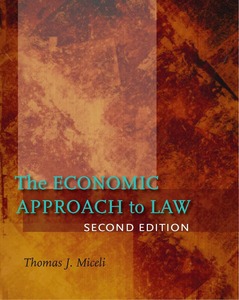Chapter 6
The Economics of Property Law: Fundamentals
Key Points
• Property rights are legally enforceable rights to use, exclude others from use of, and profit from, one’s assets. The law enforces an individual’s property rights up to the point where they become incompatible with another’s rights. In the language of economics, incompatible or incomplete property rights lead to externalities.
• Property rights create incentives for efficient exchange and production by assuring that owners have exclusive rights to the resulting profits.
• Economists have argued that property rights emerge when the gains from instituting a system of rights exceeds the costs of enforcement. Private enforcement of property rights often precedes state (government) enforcement.
• The Coase Theorem forms the core of the economics of property law (and of economics of law in general). It says that when transaction costs are low, the final allocation of resources will be efficient regardless of the initial assignment of property rights.
• The Coase Theorem, when applicable, implies the law is irrelevant with regard to efficiency. This result mirrors the Invisible Hand Theorem from welfare economics, which says that the competitive market will lead to the efficient allocation of resources regardless of the initial distribution of wealth.
• The final distribution of wealth, however, does depend on how property rights are initially assigned. This mirrors the Second Fundamental Theorem of Welfare Economics, which says that any efficient allocation can be achieved by a suitable redistribution of the initial assignment of rights.
• When transaction costs are high, the initial assignment of property rights matters for efficiency. This is true because not all value-enhancing trades will occur. In this case, legal rules replace markets as the primary means of allocating resources.
• The assignment of rights can be protected by property rules or liability rules. Property rules give owners the right to refuse any unacceptable offers to buy their rights, while liability rules only entitle them to seek compensation after the fact for seizures of their rights.
• Property rules should be used when transaction costs are low, and liability rules should be used when transaction costs are high. Property rules promote voluntary (market) exchange, while liability rules permit forced (legal) exchange. The distinction portrays the choice between markets and law in allocating resources.
• The general transaction structure describes the legal and economic framework within which exchange occurs. It involves an assignment of rights couple with an enforcement rule. This framework represents the foundation of the economic approach to law, and can be shown to encompass the basic structure of tort, contract, and property law as special cases.
• The remainder of this chapter considers consensual exchange (that is, exchange mediated by a property rule). Chapter 7 concerns non-consensual, or involuntary exchange (exchange mediated by a liability rule).
• Systems for protecting private property balance certainty of ownership against enforcement costs. In the context of land ownership, the recording system, which is the predominant system in the U.S., awards title to legitimate claimants as against current possessors. In contrast, the Torrens registration system certifies the rights of current possessors as against defrauded owners.
• Leases allow property owners to divide their rights to use of their land (or other assets) over time. Leases have historically occupied the nexus between contract and property law.
• Because leasing arrangements divide ownership and use, they potentially lead to inefficient use of an asset. Economists refer to this inefficiency as the rental externality. Legal doctrines such as the implied warranty of habitability, the duty to mitigate, and the law of waste help to alleviate this problem.
• Sharecropping represents a contractual response to inefficiencies associated with divided ownership of agricultural land. One function is to share risks of uncertain output between landlords and tenants; another is to provide both parties incentives to supply inputs into agricultural production.
• Common, or public, ownership may be superior to private ownership when the optimal scale of a given productive activity exceeds that which a single owner can optimally manage. Group ownership can be beneficial in the presence of either cost or benefit spillovers. It can also share risks associated with land ownership such as uncertain crop yield.
• Intellectual property has the characteristic of a public good in that the benefits can be simultaneously used by many. However, if ideas and inventions become public property, innovators will have no incentive to create them in the first place.
• The law of intellectual property, encompassing patents, trade secrets, copyrights, and trademarks, deals with this trade-off in various ways. Most notably, patents and copyrights give innovators exclusive rights to profit from their creations for a limited period of time.
• The doctrine of fair use, however, allows some unauthorized copying for educational or private use. The economic justification for fair use is that it allows copying that the copyright holder would have consented to in a world of zero transaction costs.
